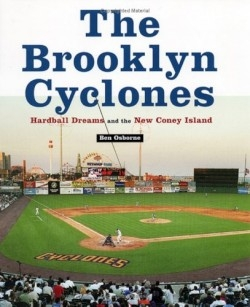The Brooklyn Cyclones
Hardball Dreams and the New Coney Island
Like peanut butter and jelly or Abbott and Costello, Brooklyn and baseball belong together. The history of this seemingly symbiotic relationship began in the mid-nineteenth century, when a professional team made its home in Brooklyn in 1884, going by several nicknames before settling on the legendary “Dodgers” in 1911.
The Yankees in the Bronx, and the Giants across the Harlem River, catered to a more upscale demographic. But the Dodgers! Ah, those beloved “Bums.” They were the champions of the common man, even when they were “stinko.”
After Jackie Robinson became the first African-American to break the national pastime’s tacit color line in 1947, the Dodgers reached a higher level of play, winning the pennant six times (and never finishing lower than third place) in eleven years. Although they lost all but one of their World Series appearances to the Yankees during that period, they gave the world that mantra of optimism, “Wait ’til next year!”
More than just a sports team, the Dodgers were a part of the community, living and shopping in the same neighborhoods as their fans. That’s why there was such a sense of abandonment when they left for the sunny shores of California following the 1957 season. In 2001, after an absence of more than forty years, the prodigals came home: the New York Mets relocated their minor league team, their New York-Penn League affiliate, from Pittsfield, Massachusetts … to Brooklyn.
In this book, the author chronicles the meaning of this return. Osborne’s grandfather grew up in Brooklyn, rooting for the Dodgers, and the author inherited a love of the team and the game. He lives in Brooklyn and is a staff writer for the basketball magazine SLAM. His articles have appeared in the New York Times, the Washington Post, and the New York Daily News.
In this book, Osborne describes how, when the Cyclones returned to Brooklyn, they nestled their new stadium, Keyspan Park, in a section of the city that once served as a playground for the wealthy. Coney Island had deteriorated into low-cost housing, boarded-up storefronts, and drug- and crime-infested streets. But the famous amusement park still held fond memories for those old enough to have been Dodger fans years ago. Perhaps it was that feeling of nostalgia (along with tax incentives) that prompted baseball and city officials to set up their latest prize there.
Osborne examines the Cyclones’ on-field performance. In their inaugural season, they finished with a record of fifty-two victories and twenty-four losses, and were poised to win the championship when the tragedy of September 11th cut short their campaign. With the playoffs canceled, the team was named league co-champion.
Their rivalry with the Yankees’ new farm team, located in nearby Staten Island, serves as a reminder of that special bond that sets Brooklyn enthusiasts apart. Cyclones fans “are much more enthusiastic than their Staten Island counterparts,” Osborne notes, pointing out that the latter group lacks “the intense borough pride that so many Brooklyn residents possess.”
Narrowing his focus on the “game within a game,” Osborne concentrates on one player, Brett Kay, a charismatic catcher from California. Many players at this level are away from home for the first time. They must learn how to survive in their new, sometimes daunting, but always supportive, environment. As Edgar Alfonzo, the Cyclones’ manager, says to the author, “I tell them that Brooklyn is different from the rest of the Minor Leagues - everybody in Brooklyn loves baseball.”
Osborne also looks at the effect that the ball club has had on its new neighbors. Does a team have any responsibility to improve the community? What consequences will it have on local residents and businesses? Osborne wonders if all the politicians? talk about civic pride, and the revival that a professional sports team would bring, was just so much hot air. In his epilogue, written with the benefit of hindsight, he notes that: “The area around Keyspan Park that is unaffiliated with the team or stadium has changed slightly since the first season ended” and that the promised improvements have “failed to materialize.?”
Will the novelty of a new team in Brooklyn soon wear off? After all, major league teams like the Pittsburgh Pirates, Cincinnati Reds, and Detroit Tigers all moved into new ballparks recently, but they suffered a noticeable drop-off in attendance after their inaugural years. It seems likely, however, that fans will continue to come out for the Cyclones. Whether that success will translate into an improved infrastructure remains to be seen.
Osborne and the ballplayers also know that the chances of a minor leaguer making it to the majors are slim. But then, so were the odds that the professional game would ever come back to Brooklyn.
Reviewed by
Ron Kaplan
Disclosure: This article is not an endorsement, but a review. The publisher of this book provided free copies of the book to have their book reviewed by a professional reviewer. No fee was paid by the publisher for this review. Foreword Reviews only recommends books that we love. Foreword Magazine, Inc. is disclosing this in accordance with the Federal Trade Commission’s 16 CFR, Part 255.

